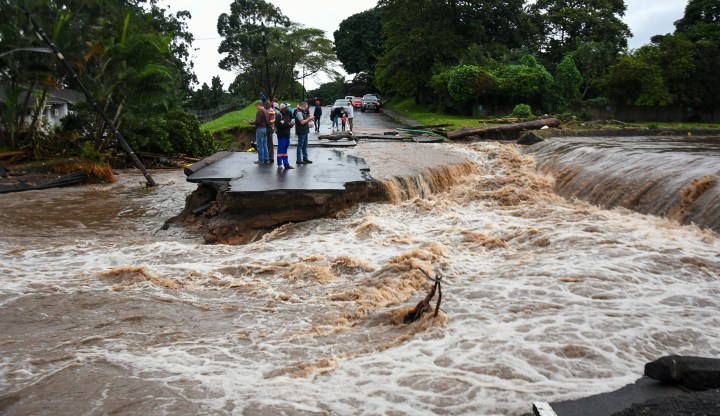EXTREME WEATHER WOES
Half the world still lacks multi-hazard early warning systems, global disaster risk reduction report finds

While more people are being protected from the impacts of extreme weather by early warning systems, half of all countries still don’t have such systems.
Africa has made strides in enhancing the quality of its extreme weather early warning systems, but the continent still lags behind the global average.
This was revealed in a new report by the United Nations Office for Disaster Risk Reduction (UNDRR) and the World Meteorological Organization (WMO).
The 2023 Global Status of Multi-Hazard Early Warning Systems Report was released during COP28 and analyses the latest data one year into the Early Warnings for All Initiative (EW4All), which aims to cover all countries with early warning systems by the end of 2027.
The lack of early warning systems is hardest felt across Africa, Small Island Developing States and Least Developed Countries. Where comprehensive early warning systems do exist, there are often challenges that undermine their effectiveness — particularly in disaster risk knowledge, observations and forecasting, dissemination and communication, and preparedness to respond.
EW4All was formally launched by the UN secretary-general at the COP27 meeting in Sharm El-Sheikh. Now, one year into the initiative, the new report found more lives are being protected from extreme weather and dangerous climate change impacts but there is a long way to go, as half of all countries still do not have adequate multi-hazard early warning systems.
Less than 50% of the Least Developed Countries and a mere 40% of Small Island Developing States (Sids) possess comprehensive multi-hazard early warning systems. Notably, in the Arab states, the level of risk knowledge crucial for supporting robust early warning systems was identified as particularly deficient.
The report found that 101 countries had early warning systems, six more than last year, representing a doubling of coverage since 2015.
The focus now is on scaling up support in more countries and securing the finance to deliver Early Warnings for All in the next four years.
UN Secretary-General António Guterres called on states to double the speed and scale of support to countries in 2024.
“What we are delivering under the EW4All initiative can protect and save vulnerable communities from the worst impacts. This is an ambitious goal — but it is also achievable… For us to make it a reality we need all hands on deck rowing in the same direction — collaborating and cooperating in a way that we have not done before.”
Global progress
Specific national action plans and coordinating mechanisms are in place for Ethiopia, Laos and the Maldives. Benin has improved communication to reach its most vulnerable communities and, according to Guterres, Fiji’s flash flood warning has been upgraded to safeguard the country’s almost 1 million residents.
More than 400 million people in Least Developed Countries and Sids now have access to improved forecasts and alerts for heatwaves, floods, droughts and tropical cyclones.
According to the report, 30 nations are at the forefront of advancing early warning systems and regional plans in Africa.
“The progress is encouraging but we must not be complacent. With an 80% increase in the number of people affected by disasters since 2015 and half the world still lacking access to early warnings, it is imperative to take action now to save lives, livelihoods and assets,” said Mami Mizutori, the head of the UNDRR.
Effectiveness in South Africa
South Africa, a signatory of the EW4All initiative and already facing an increasing number of disaster events, has an early warning system in place, but it has limitations.
Read more in Daily Maverick: ‘It will never be the same’ — life after climate displacement, and why we need to prepare communities
Francois Engelbrecht, a professor of climatology and director of the Global Change Institute at Wits University, said the Durban floods of 2022 demonstrated the limitations of the system.
“Somewhere in the early warning cycle serious failures occurred as almost 500 people lost their lives. But where did these failures occur? First and foremost, the warning issued by Saws [SA Weather Service] was not strong enough.
“It did see the weather system, which was a cut-off low system approaching, and there were some warnings of extreme or severe weather, but the highest levels of warning were issued late when the flood event and the heavy rainfall were already in motion,” he said.
Engelbrecht said disaster risk management officials send links to television, radio and cellphones that disseminate warnings.
Relationship of trust
“But even that is often not enough to get communities to take action on the warnings. So in the last step of this warning system, we nowadays think they need to be community-based. You need to have a relationship of trust, specifically with the most vulnerable communities that you need to respond to the warning,” he said.
A relationship of trust would ensure that communities evacuate quickly, leaving their possessions behind, when warned of a disaster headed for their area.
Engelbrecht said it was of the utmost urgency to improve disaster warning systems in developing countries to avoid further devastation and loss of lives as extreme climate events continue to ravage the world.
Saws spokesperson Hannelee Doubell said increasing disasters made it more important than ever for early warnings to be successful and understandable.
Early warning roadmap
Saws has been working on an early warning roadmap to increase the reach of weather warnings in South Africa.
Saws issues impact-based weather warnings, which warn against the possible impacts of hazardous weather. This system went operational in 2020 after a long pilot phase.
The National Disaster Management Centre (NDMC) then puts these impact-based warnings on web applications that are available to the public. Similarly, the fire danger early warning system provides early warnings and situational awareness of fires across South Africa.
The NDMC also hosts a tropical cyclone tracker that uses data from the National Oceanic and Atmospheric Administration to track and forecast tropical cyclone paths in near real-time.
The NDMC said early warnings were valuable in mitigating the effect of hazardous events. Its objective was to promote “early warnings, early action” with standardised guided initiatives (including the establishment of joint operations centres).
Improving the systems
The intensification of climate change poses an existential threat to vulnerable nations, necessitating urgent and robust responses. While strides have been made in fortifying early warning systems, challenges persist that require immediate attention and concerted global action.
Even with accurate technical guidance of imminent impacts, early warning systems may fail due to a lack of uptake and community engagement, including in the most vulnerable communities.
Investments in infrastructure, technology and community engagement are imperative for creating effective early warning systems. However, financial constraints, inadequate international cooperation and a lack of comprehensive community engagement strategies hinder this progress.
Addressing these challenges requires a collaborative effort that transcends borders. The international community must acknowledge its shared responsibility and take decisive action to support vulnerable nations in their quest for climate resilience. Only through concerted efforts can we hope to build a world where early warning systems are effective bulwarks against the rising tide of climate change, safeguarding the lives and livelihoods of those most at risk.
The WMO-UNDRR report recommends investing in risk governance as a proven basis for enabling effective early warning systems; enhanced data and harnessing technological opportunities are also highlighted as a key area for action to leverage mobile networks and internet connectivity, for stronger hazard monitoring and faster communication of warnings.
The report also emphasised intensified efforts to ensure isolated communities have early warning systems that can reach everyone and are based on local needs, as well as the need to strengthen anticipatory action for better preparedness. DM



















 Become an Insider
Become an Insider
Comments - Please login in order to comment.